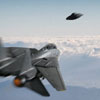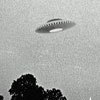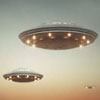UFOs: The True Story Of Flying Saucers
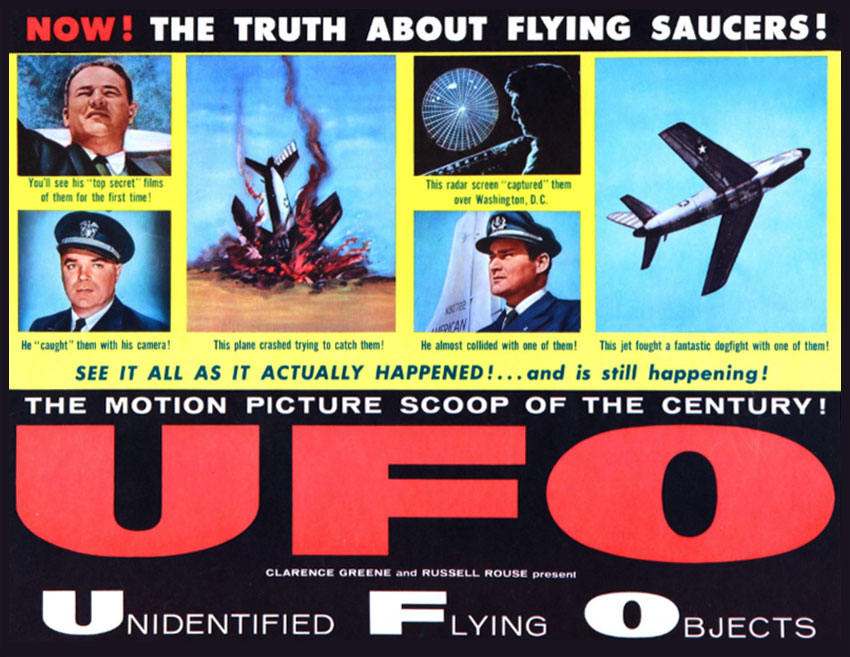 “UNIDENTIFIED FLYING OBJECTS” – A Most Remarkable UFO Documentary Film
“UNIDENTIFIED FLYING OBJECTS” – A Most Remarkable UFO Documentary Film
Unidentified Flying Objects is a 1956 documentary about the development of the UFO phenomenon in the United States. It is considered to be the first UFO documentary ever made. Since that time, video clips from the documentary have often been used in other UFO documentaries and television episodes related to UFOs.
In 1952 Hollywood producer Clarence Greene saw an unusual object twisting in the sky. He decided to report the sighting, and contacted US Air Force public information officer Albert M. Chop, who was in charge of answering UFO questions from reporters and the public. Intrigued by his experience, Greene decided to film a documentary movie about the UFO phenomenon. When Chop told Greene about the existence of video footage of UFOs, Greene obtained the footage for analysis and display in his documentary.
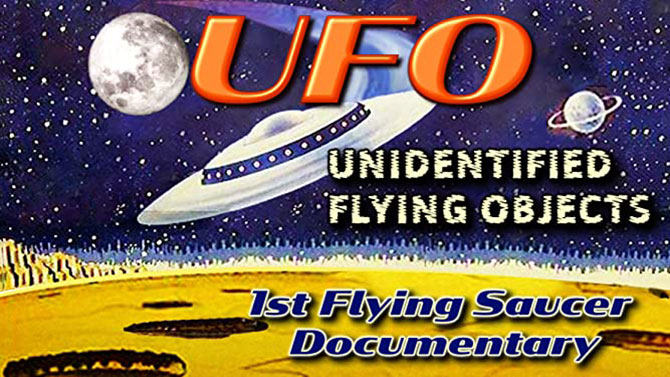 The documentary starts in 1947, with the first widely-publicized UFO sightings in the United States, including recreations of the Kenneth Arnold UFO sighting, the Mantell UFO incident, and the Gorman Dogfight. It then traces the development of UFOs as both a popular fad and a serious concern for the US Air Force. The history of Project Sign, the first Air Force study of the UFO phenomenon, is discussed. The documentary then focuses upon Albert M. Chop and his growing involvement with UFOs. Chop is assigned as the public information officer at Wright-Patterson Air Force Base in Dayton, Ohio, in the late 1940s. In that position he is required to answer numerous news media queries about UFO sightings and what the Air Force knows about them. Although he is initially portrayed as a UFO debunker, Chop gradually changes his views as the movie progresses, and he comes to believe that UFOs are unknown, and possibly extraterrestrial, aircraft. By 1952 Chop has moved to Washington, DC, where he is the press officer for Project Blue Book. The documentary analyzes two famous pieces of UFO footage: the Mariana UFO Incident of 1950, in which the manager of the Great Falls, Montana minor-league baseball team claimed to have filmed two UFOs flying over the baseball stadium, and the 1952 UFO film taken near the Great Salt Lake in Utah by a US Navy photographer, Delbert Newhouse. The documentary concludes with the famous 1952 Washington DC UFO incident, in which Albert Chop played a central role. The documentary recreates Chop’s experiences during the incident, and at the end of the documentary Chop states his belief that UFOs are a “real”, physical phenomenon of unknown origin.
The documentary starts in 1947, with the first widely-publicized UFO sightings in the United States, including recreations of the Kenneth Arnold UFO sighting, the Mantell UFO incident, and the Gorman Dogfight. It then traces the development of UFOs as both a popular fad and a serious concern for the US Air Force. The history of Project Sign, the first Air Force study of the UFO phenomenon, is discussed. The documentary then focuses upon Albert M. Chop and his growing involvement with UFOs. Chop is assigned as the public information officer at Wright-Patterson Air Force Base in Dayton, Ohio, in the late 1940s. In that position he is required to answer numerous news media queries about UFO sightings and what the Air Force knows about them. Although he is initially portrayed as a UFO debunker, Chop gradually changes his views as the movie progresses, and he comes to believe that UFOs are unknown, and possibly extraterrestrial, aircraft. By 1952 Chop has moved to Washington, DC, where he is the press officer for Project Blue Book. The documentary analyzes two famous pieces of UFO footage: the Mariana UFO Incident of 1950, in which the manager of the Great Falls, Montana minor-league baseball team claimed to have filmed two UFOs flying over the baseball stadium, and the 1952 UFO film taken near the Great Salt Lake in Utah by a US Navy photographer, Delbert Newhouse. The documentary concludes with the famous 1952 Washington DC UFO incident, in which Albert Chop played a central role. The documentary recreates Chop’s experiences during the incident, and at the end of the documentary Chop states his belief that UFOs are a “real”, physical phenomenon of unknown origin.
Perspective – The First UFO Documentary Ever Made
“Many times in the history of our civilization the introduction of a new thought has brought skepticism, even ridicule. Despite this, there always has remained the duty and inalienable right to tell the people the truth. The Motion Picture you are about to see is true. It is not fiction. Much of the information in it has never been told. You will see it here for the first time.”
Unidentified Flying Objects: The True Story of Flying Saucers (1956)
Most science fiction movies which have dealt with the UFO topic have done so in anything but a sober fashion. But, if, you happen to watch the late-late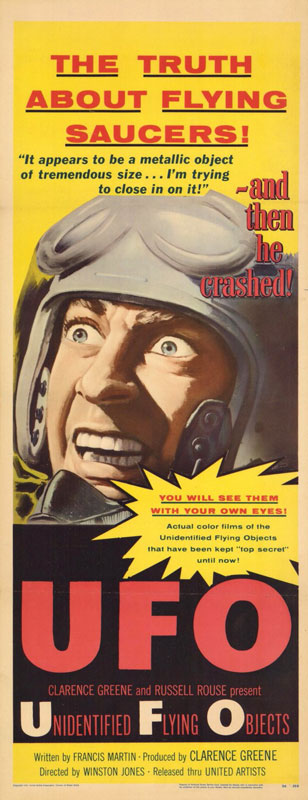 show on TV, you might be lucky enough to catch the pioneer of serious UFO documentaries — a film entitled, appropriately enough, “Unidentified Flying Objects.” You’ll be in for a real treat.
show on TV, you might be lucky enough to catch the pioneer of serious UFO documentaries — a film entitled, appropriately enough, “Unidentified Flying Objects.” You’ll be in for a real treat.
Every few weeks, somewhere in the United States or overseas, a TV station airs an old 1956 motion picture on its late-late show or afternoon movie feature. TV Guide lists its title as “U. F. 0.,” though the more wordy program logs might print the elaborate title of the United Artists release, “Unidentified Flying Objects.”
Filmed primarily in black and white (except for two short, authentic UFO movies, shown in their original color), this Clarence Green-Russell Rouse production enjoyed only less than moderate success during its initial release to international movie houses 21 [now 67] years ago.
However, a recent research session on the film’s background, which led me to contact people in 17 cities among 12 states, convinced me that “U. F. 0.” is truly a documentary, dealing fairly and, for the most part, accurately with the UFO subject as it was treated by the U.S. Government during the late 1940’s and early fifties.
And “U.F.O.” is a remarkable piece of work for its time. Whereas the other major studios have only recently considered the UFO theme for serious motion picture productions, the 1956 United Artists documentary was a far-sighted film. Most of the science-fiction movies which inundated the fifties, you may recall, dealt with the UFO topic in anything but a sober manner!
What was “U.F.O.” about? On the surface, it seemed to make a good case for the existence of UFOs. In a deeper sense, the movie explores a very important historical aspect of the official U.S. investigation of the aerial phenomenon.
Unfortunately, United Artists’ U.S.A. pressbook did not describe the film’s storyline in detail, but a rare copy of the London, England “U.F.O.” pressbook that I stumbled upon does. Following, then, is United Artists’ English synopsis of the motion Picture—which I have paraphrased and added to in some spots in order to include other related material about this true motion picture account.
This writer, who openly confesses his respect for “U.F.O.,” urges that the reader be on the lookout for the movie. I hope, too, that you enjoy viewing a few of the rare promotional photos herein that accompanied the film during its theater days.
 SYNOPSIS
SYNOPSIS
(1956 Press Release by United Artists Corp., notes in italics added by Robert Barrow)
When Albert M. Chop (played by Tom Towers, a veteran newsman) reported to work on the Public Information Office desk of Air Materiel Command at Wright Patterson Air Base early in 1950, he airily dismissed press queries about Unidentified Flying Objects with, “This whole saucer business is pure, unadulterated bunk.” He believed this despite all reports of sightings and the death of Captain Mantell, in 1948, while chasing a flying saucer.
Promoted to Chief of the Press Section at A.M.C., he soon began to have doubts. Startled to find that a famous scientist, Dr. Reiskaywitz, had an open mind on flying saucers, it was unsettling for Chop to learn from the Public Information Officer that Project Sign had not been closed down but merely renamed Project Grudge. Most disturbing of all was the Colonel’s reluctance to express any opinion on flying saucers.
When Chop was transferred to the Press Section in the Pentagon, by the special request of Col. Richard Searles, he felt sure he was finished with flying saucers. Instead, he was assigned directly to the investigation. Project Grudge was expanded and renamed Project Bluebook by U.S. Air Force Intelligence and Captain Edward J. Ruppelt was made chief of it. (Ruppelt played himself in the movie, adding to its historical value and authenticity).
Soon afterwards, Chop (the real Albert Chop approved every line of the script dealing with himself) learned from Major Dewey Fournet of Current Intelligence Branch, that the Air Force actually had motion pictures of U.F.O’s. Fournet showed him the Montana film, explaining that, after thorough analysis, the objects remained unidentified (the real Dewey J. Fournet, like Chop, also approved every line in the script regarding his official activities, though Fournet’s role was played by an actor).
Chop also learned that more film had been shot in Utah by Navy Photographer Newhouse (Delbert Newhouse himself was interviewed in the movie), and that Ruppelt and his staff were analyzing it. Later, after studying thousands of reports and analyses of sightings, Chop joined the top Pentagon brass for a viewing of the secret Utah film (Nicholas Mariana, having photographed two UFOs in Montana, also appeared in the documentary). The reports stated, “Not balloons, not aircraft, not birds, not faked.” The Official conclusion was “Unknowns.” The Utah film was never shown to the press, nor was its existence revealed (until much later).
On July 20, 1952, the Unknowns moved in for the first time over Washington, D.C.–Chop, who had slept through it all, was mobbed by queries from editors all over the country.
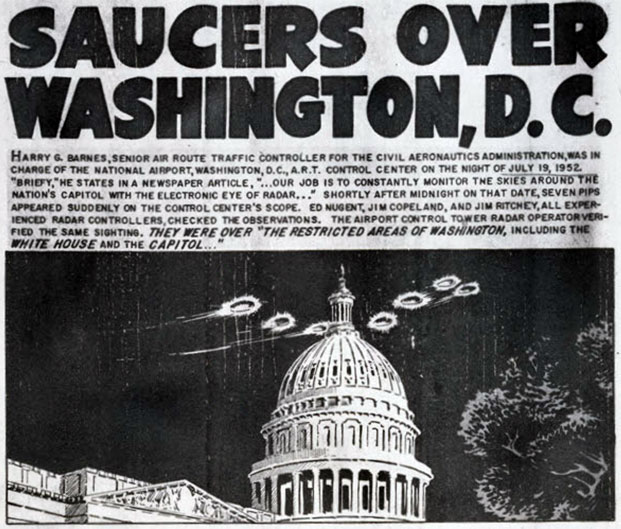 One week later, the night of July 26, Chop was called to C.A.A. Headquarters. Radar was again picking up Unknowns over the Nation’s Capital. For six hours, Chop and Major Foumet were eye witnesses to the radar contact while UFOs hovered over Washington. Jet interceptors were sent up, and visual contact was made in addition to the radar sightings. This incident also was kept secret from the press and public. Even the White House was misinformed.
One week later, the night of July 26, Chop was called to C.A.A. Headquarters. Radar was again picking up Unknowns over the Nation’s Capital. For six hours, Chop and Major Foumet were eye witnesses to the radar contact while UFOs hovered over Washington. Jet interceptors were sent up, and visual contact was made in addition to the radar sightings. This incident also was kept secret from the press and public. Even the White House was misinformed.
The press demanded explanations. They knew that interceptors had been sent up, and now they wanted the facts. The Chief of Staff ordered a press conference the next day (film clips from the conference are included in the movie). Chop and Ruppelt were present when General Samford stated there were “credible observers of relatively incredible things.”
From that night on, Chop was convinced there was no longer any controversy as to whether or not there were U.F.O’s moving in the atmosphere. They were an undeniable fact. The only questions left now were, “What are they?” and “Where do they come from?” He was also convinced that there was intelligence behind the objects and that their source was space.
(A final note: In the years following his own official UFO activities and the production of “U.F.O.,” the real Mr. Albert M. Chop has considered other UFO theories besides the extraterrestrial idea, though he still, to this very day, remains certain that the phenomenon is real and demands a full investigation.)
Additional earlier review by Robert Barrow – link
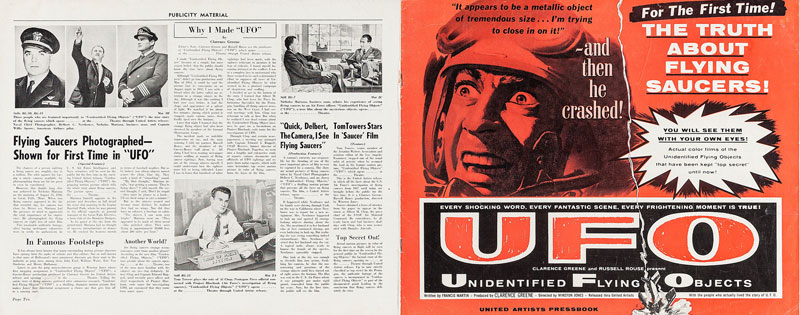 Later Statement Regarding “U.F.O.” Documentary – by Robert Barrow
Later Statement Regarding “U.F.O.” Documentary – by Robert Barrow
Now that the U.S. government has expressed a generally positive public attitude regarding the UFO phenomenon and the necessity for a truly scientific investigation, I think it is clear that Clarence Greene was a visionary. Yes, he was a partner in Greene-Rouse Productions, and he and his partner Russell Rouse created some good motion pictures, but “U.F.O.” was primarily Greene’s idea. Armed with a small budget and a bold, yet sensible plan, he forged ahead to document a peculiar truth in an era cluttered by science-fiction films which saturated theater audiences with fake monsters and bizarre creatures sired by nuclear radiation gone wrong.
In essence, while bizarre space creatures and vampires occupied the attention span of theater popcorn munchers, often leaving them screaming in the aisles, Clarence Greene’s 1956 release came and went with nary a national whimper among movie houses, yet the story he told left behind a thousand shadows of mystery to keep us wondering then and now.
Decades have passed and UFO researchers in large part seem comfortable now with a conventional explanation for Capt. Mantell’s “UFO”chase, as they also do for the Lt. Gorman UFO incident (depicted briefly in the film without names used), but the 1952 Washington, DC UFO encounters continue to hold up well, as do depictions of the main character Al Chop (Tom Towers), and others integral to the early history of government UFO investigations.
Writing a few articles about the movie over the years was something I felt compelled to accomplish. My one regret, based upon faulty information, is reporting that Project Bluebook’s Edward J. Ruppelt played his own part in the film, which he did not. When I wrote the first article for Official UFO in the seventies I did not have access to a lot of Ruppelt’s photos, and because the actor chosen did bear a striking resemblance to Ruppelt I simply accepted what I had been told. Subsequently, I have tried to correct this misinformation when possible.
But historical emphasis really must be placed upon Clarence Greene’s efforts. Sadly, things don’t always go well for those who see, those who know, those who try. Years passed and Greene reportedly died impoverished in a Los Angeles nursing facility. ~ Robert Barrow, September 22, 2021
More on the film here.
Posted in Other Topics, UFOswith comments disabled.



